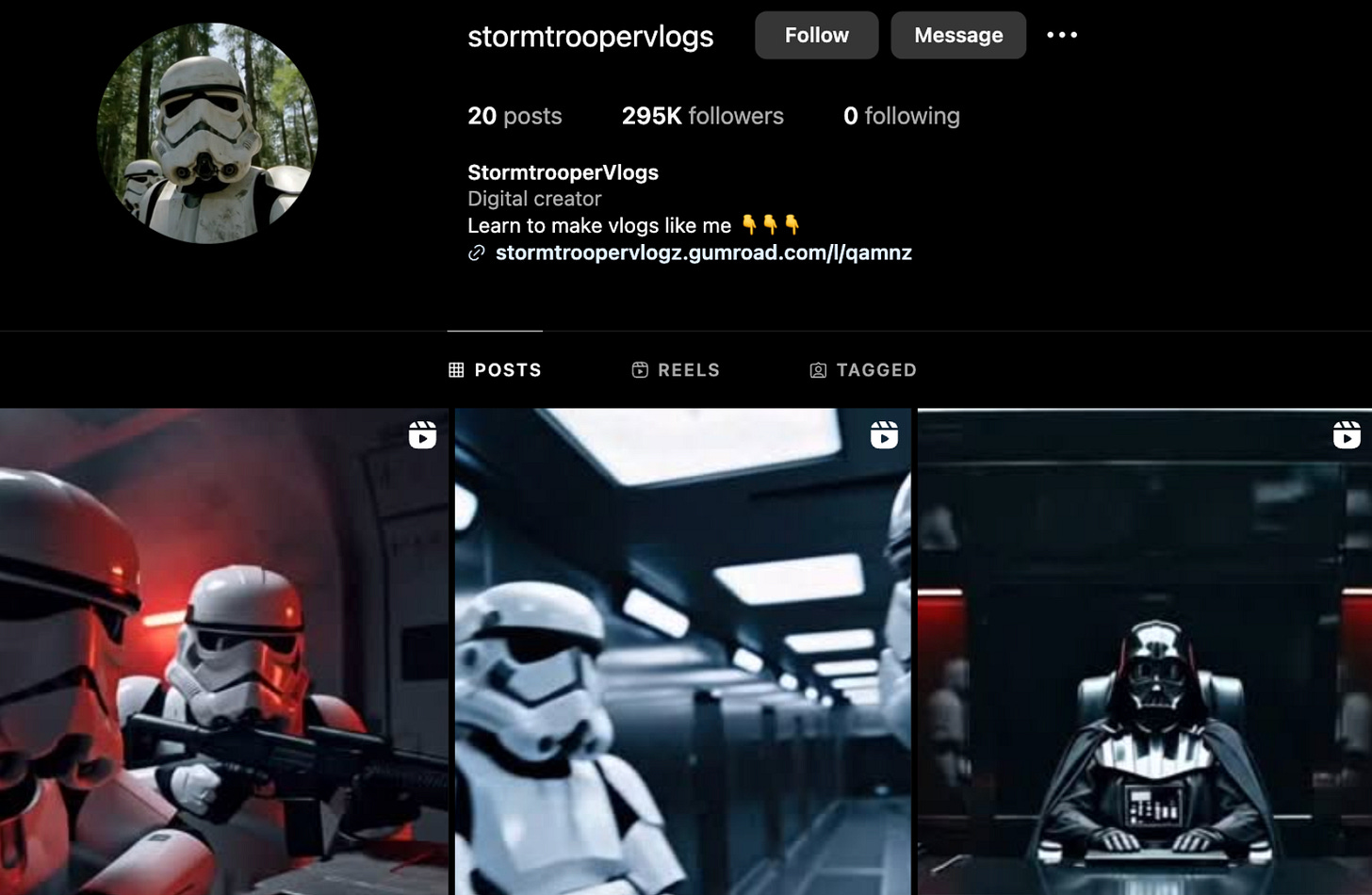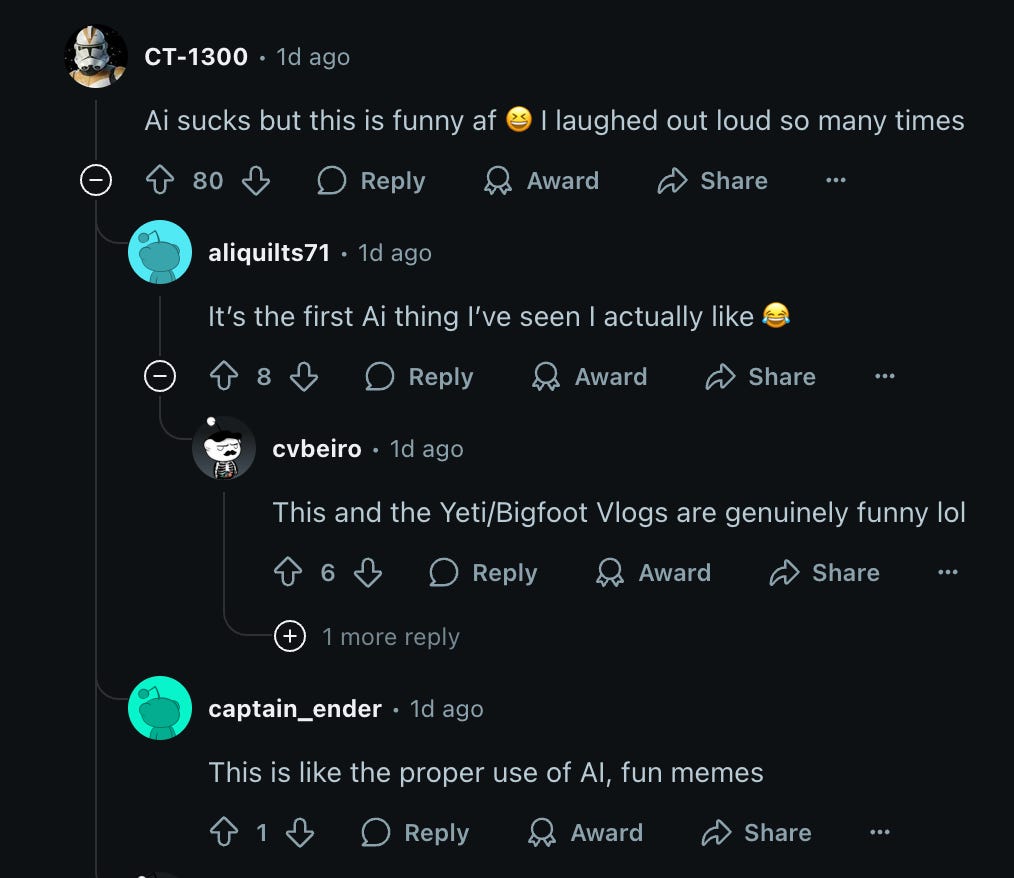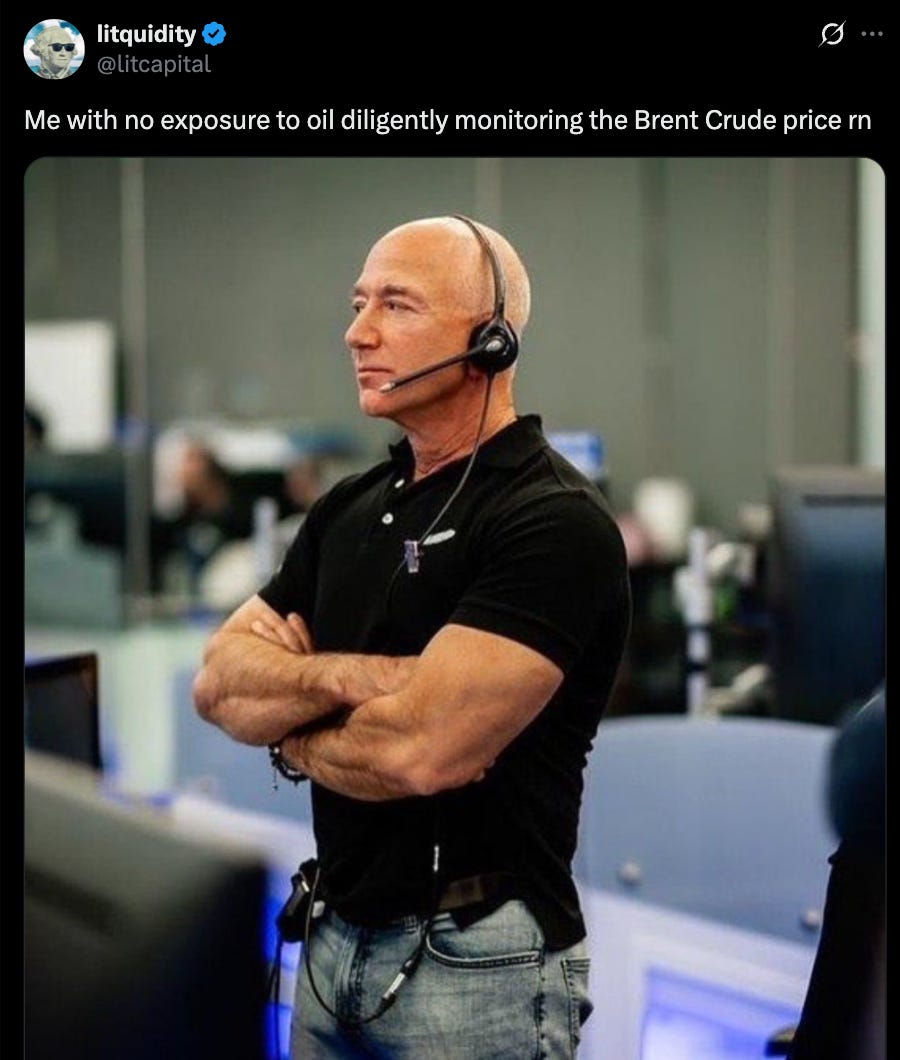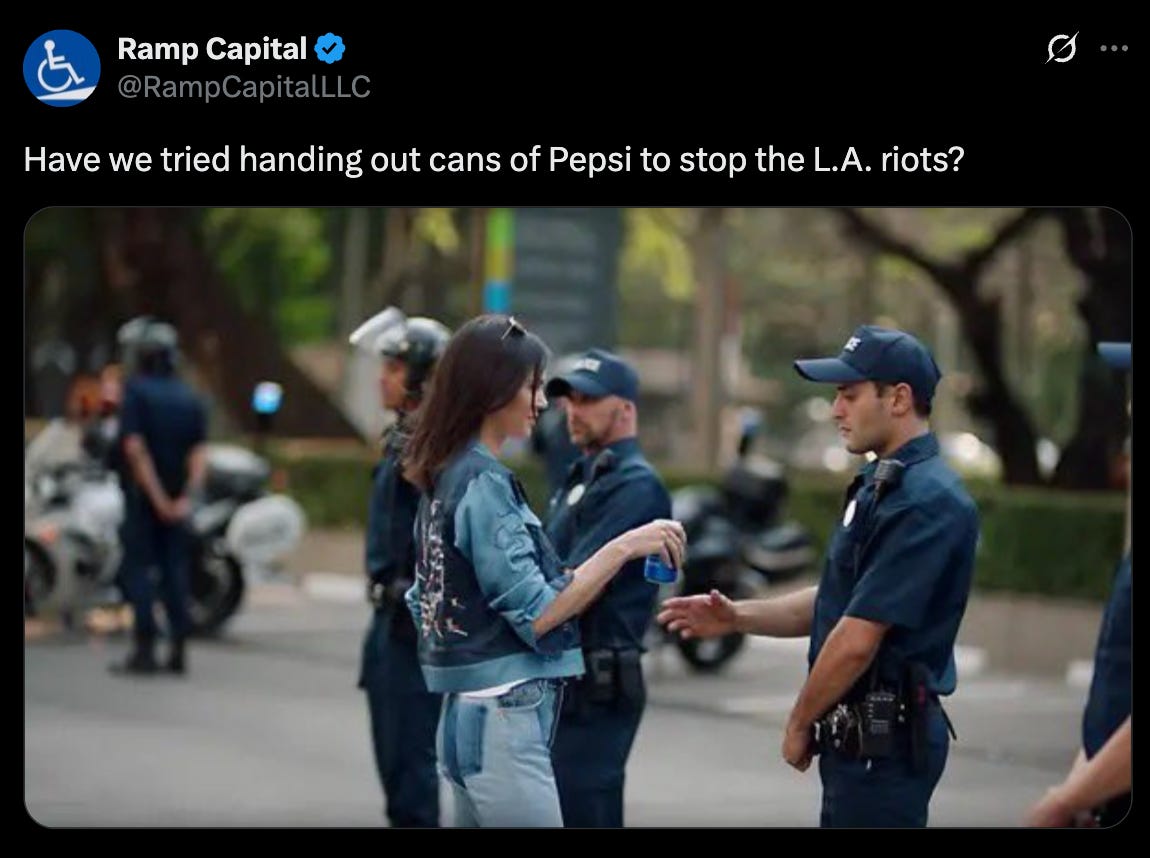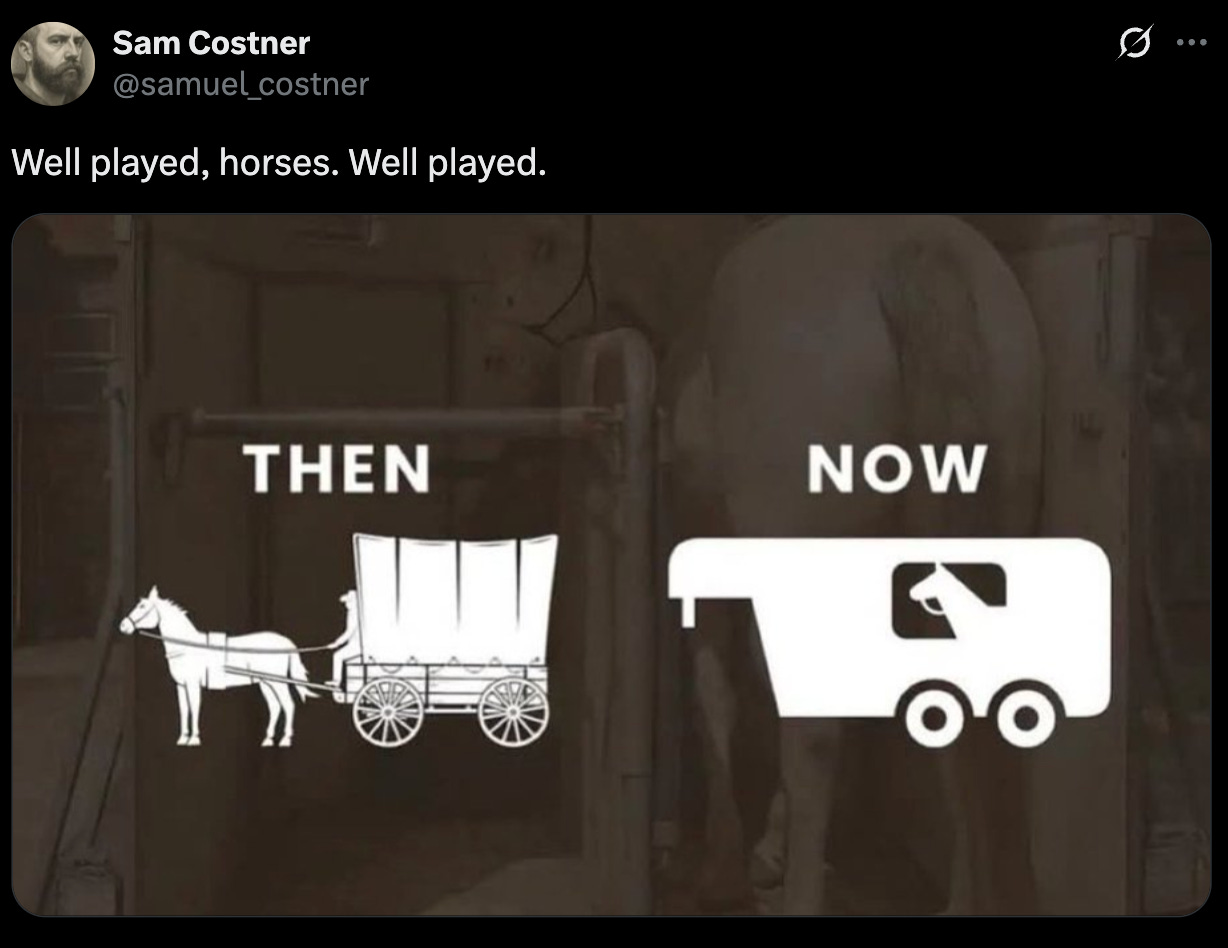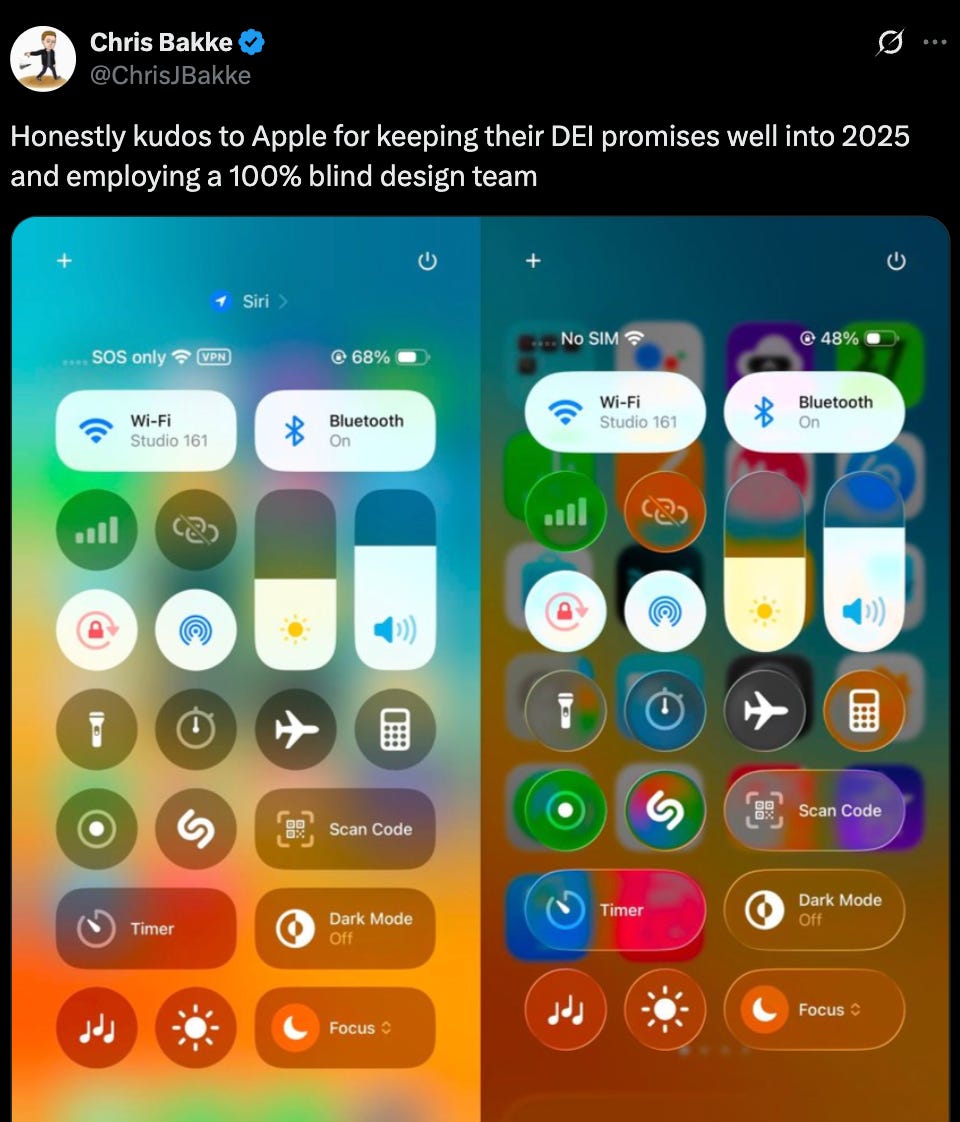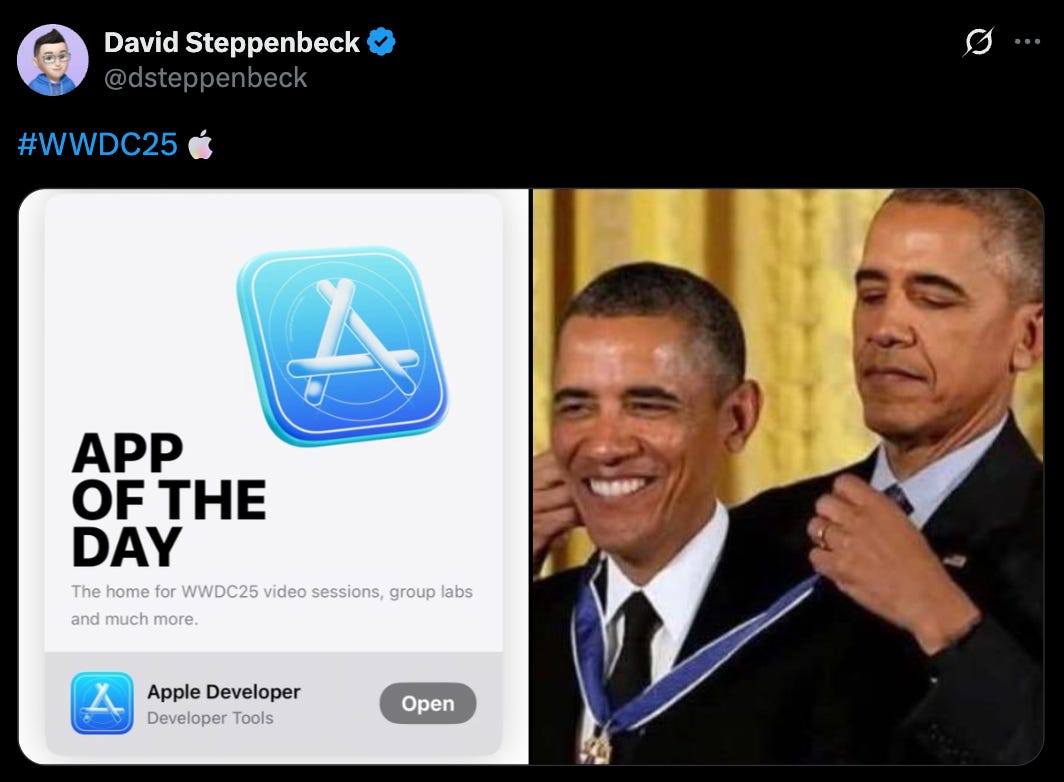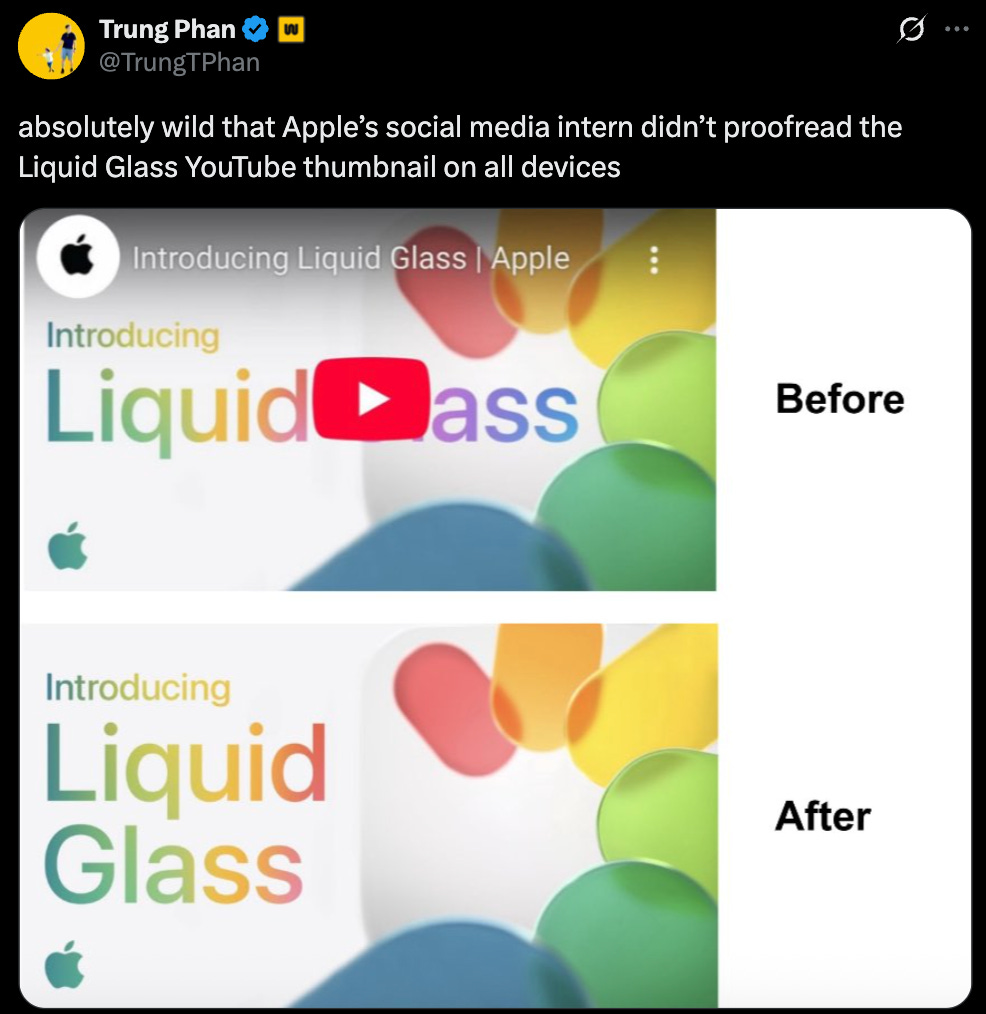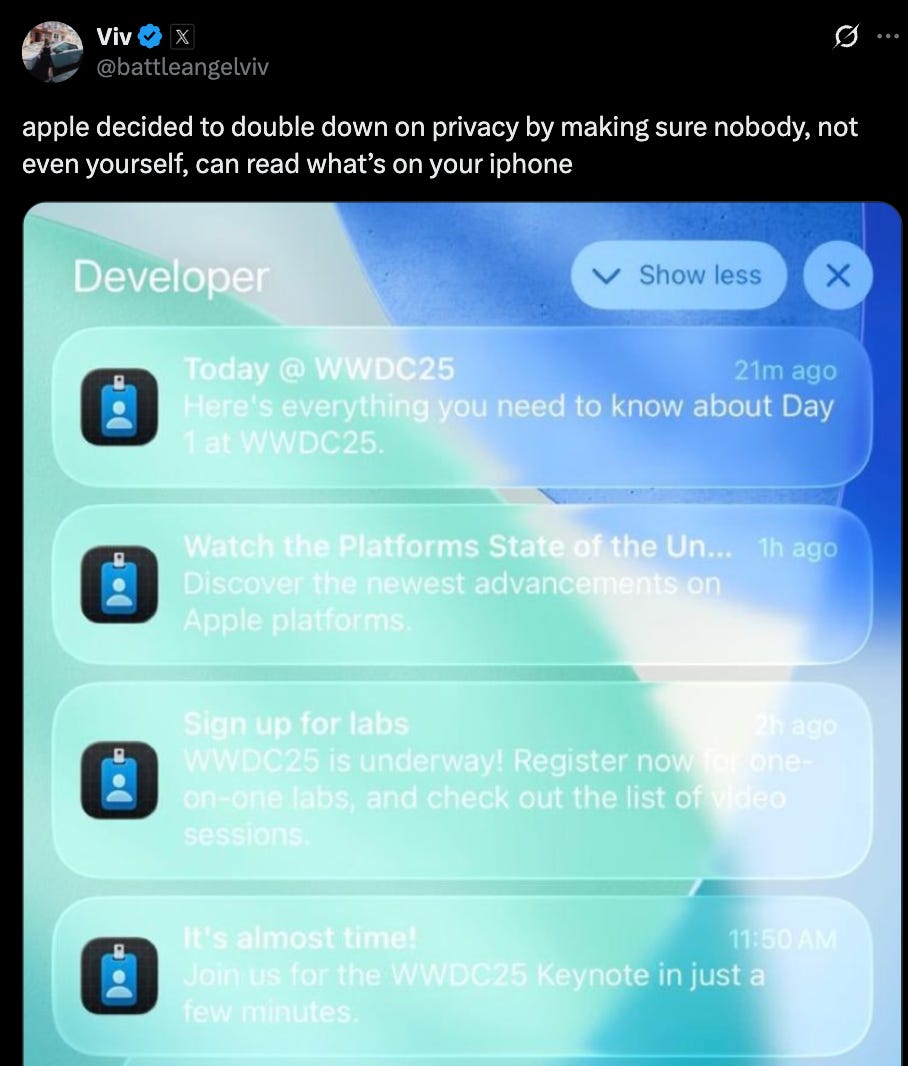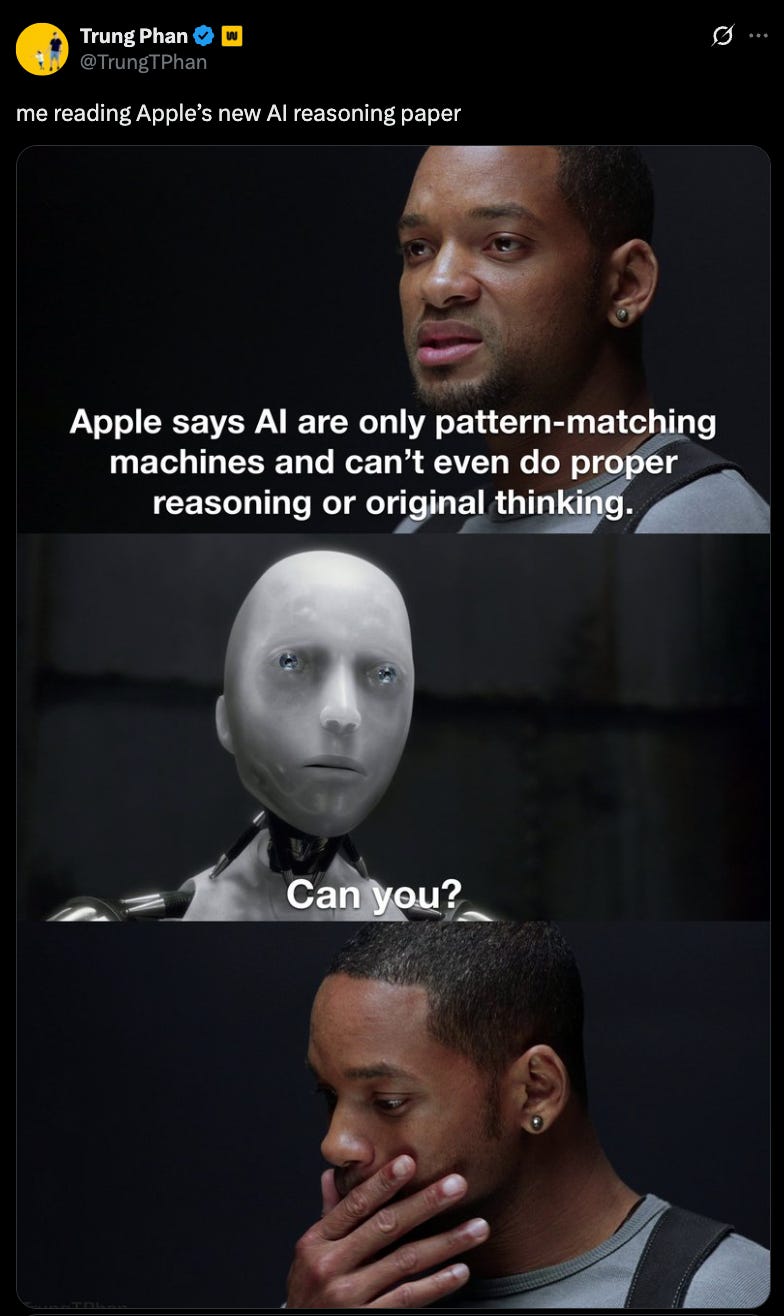Star Wars, Veo 3 and Hollywood in the Age of AI Video
PLUS: Apple WWDC Memes, Nintendo Switch 2 Launch.
Thanks for subscribing to SatPost.
Today, we talk about a viral new AI-generated Star Wars Instagram account and what it says about the future of Hollywood.
Also this week:
Reddit Sues Anthropic
Nintendo Switch 2, N64 and Goldeneye
…and them fire posts (including Apple Liquid Glass)
There’s a new Instagram account called StormTrooperVlogs.
The account owner uses Google’s Veo 3 to crank out entertaining Star Wars parody short videos (30-60 seconds) with plots surrounding a clumsy stormtrooper named Greg and his vlogging colleague.
In a week, StormTrooperVlogs went from 0 to ~300k followers after posting 20 videos.
Frankly, it’s incredible fan fiction and a useful window to view Hollywood’s future challenges and opportunities.
First, let me explain why StormTrooperVlogs slaps so hard.
I don’t want to be hyperbolic…ok, yes I do: this is the most satisfying Star Wars content since Disney acquired Lucasfilm in 2012.
Among real fans, Andor seems to have reached the peak of post-Disney Star Wars art. Created by Tony Gilroy — who also directed the well-received Star Wars prequel film Rogue One — Andor is a two-season TV show that takes place 5 years prior to the plot of the first 1977 Star Wars film and shows how a thief-turned-spy joins a growing Rebel movement to take on the Galactic Empire.
The Star Wars universe has been well-covered for decades, but Andor lets us view it from a new angle (low-level Empire officials, radicalizing galactic citizens) and a different type of genre than the standard space-opera blockbuster (there is a lot of spycraft, which is unsurprising as Gilroy wrote the scripts for the Bourne Identity films).
Similarly, StormTrooperVlogs lets us view a well-known IP through the eyes of the most throwaway and faceless character (stormtroopers) in a different but familiar genre to anyone that has scrolled short-form videos in the 2020s (“day in the life of office worker” vlogs).
The “day in the life of office worker” vlog format works really well with Veo 3 because Google’s video-generating AI tool can only create 8-second clips at a time. It’s also beneficial that the Stormtroopers are wearing masks because perfectly aligning facial movements with the audio will always be a challenge.
Using this formula, StormTrooperVlogs has given us:
The Battle of Endor (the stormtroopers are pissed that they have to go to a forested planet because “orders just came in from Vader’s bitch ass” and they are chased around by “teddy bear”-looking creatures aka Ewoks)
The Battle of Hoth (they crash land on the icy planet and Greg is building a snowman while they are shot at by Rebel troops)
Tatooine (they head to Luke Skywalker’s home planet to fix their vehicle and take a break to “drink something suspicious” in a local watering hole while Greg gets beat up in a bar fight)
There are clear trademark and copyright questions but I suspect StormTrooperVlogs meets the bar for “fair use”. It is both transformative (stormtroopers are vlogging about work while shitting on their boss Vader) and parody (stormtroopers are vlogging about work while shitting on their boss Vader).
Historically, George Lucas was fine with works that expanded interest in the Star Wars universe and never really had a problem with fan fiction as long as people weren’t monetizing the content…because Papa George always made sure to get a cut of any IP usage. I mean, Lucas literally OK’d Mel Brooks’ Spaceballs just as long as the comedy legend didn't sell merchandise (PS. the 98-year old Brooks just announced he’s making a sequel). Even Disney has allowed large fan-fiction Star Wars archives to stay on the internet (although it did go after someone that ran a “Lightsaber Training Academy”, which fair enough).
Disney may very well go after Google, though. Along with Universal, it just rolled out a lawsuit against AI-image and video platform MidJourney for unlicensed use of IP including Star Wars, The Simpsons and Minions. However, based on a statement from Disney’s Chief Legal Officer, it sounds like the studios are fine with the existence of AI tech but just want to get paid: “We are bullish on the promise of AI technology and optimistic about how it can be used responsibly as a tool to further human creativity.”
There are parallels to YouTube’s early days. In 2008, Viacom sued the video-sharing platform for $1B for allowing the upload of copyright content. One major reason YouTube even agreed to its 2004 acquisition by Google for $1.65B was the prospect of dealing with future legal fees. Google’s solution was to create the Content ID system which automatically identified copyright material and let the owner either monetize the property or have it taken down. An internet-scale problem needed an internet-scale solution. Many media IP owners chose the monetization route and have been paid.
Licensing around AI training and outputs has already started and Google is in a position to build a Content ID-like system for any AI-generated text, videos and images. TBH, Disney and Universal look like they’re aiming for a quick PR win among creatives by going after MidJourney, which does ~$500m ARR but is a minnow compared to Big Tech (the odds feel high that Hollywood is working on a larger deal with leading AI labs to guarantee a cut and tries to limit brand-unfriendly outputs).
Before anyone yells at me, let me say three things: 1) “I’m not suggesting this is the perfectly ideal situation, but the cat is out of the bag”; 2) “none of this is legal advice”; and 3) “I didn’t say Greg The Stormtrooper was better than Andor, I said it was more satisfying”
Look, I’m a sucker for workplace humor because I’ve known many “Gregs” in my life. Hell, the bosses at my first three corporate jobs probably thought I was the “Greg”. To have that character thrown into a Star Wars Universe with decent visuals while calling Vader a “bitch ass” is very satisfying…and ain't no way Disney was doing this on their own.
There have been previous viral Star Wars videos parodies — including the Auralnauts series that re-dubbed Star Wars films as comedies (and Adam Driver doing an actual Kylo Ren workplace parody for SNL) — but Veo 3 opens the door to infinite possibilities.
Key stat: the two seasons of Andor cost over $600m while StormTrooperVlogs probably cost less than $1,000 in Veo token for each clip (this assumes the creator needs 20 usable Veo clips, which probably requires 100 total prompted videos…at ~$5 for an 8-second prompted video, that would be a total of $500 and then add on time spent editing).
This takes us to our second question: what does StormTrooperVlogs tell us about the opportunities and challenges for Hollywood?
While AI-generated text is already flooding the internet, we are on the cusp of video doing the same.
Doug Shapiro — former Head of Investor Relations at WarnerMedia — writes widely on the shift and has a useful model that explains four potential scenarios on how the spread of AI-generated video could play out.
Let’s start with Shapiro’s overarching thesis:
I often write that the last 10-15 years in video have been defined by the disruption of content distribution and the next 10 years are poised to be defined by the disruption of content creation.
Here’s the argument: The internet unbundled information from infrastructure and, with the help of a host of related technologies and massive infrastructure investment, caused the cost to move bits around to functionally head toward zero. We know what happened next. Now, there is another emerging general purpose technology, GenAI, that may send the cost to make bits to head toward zero, too.
Shapiro also clarifies that he views GenAI videos as “tools that augment and streamline human creativity, NOT fully-autonomous AI-generated video.”
Take the example of StormTrooperVlogs. These were not “one-shot” creations with a single prompt. The creator had to prompt several clip then cut them together using video editing software (unsurprisingly, StormTrooperVlogs sells a Gumroad course on how to make Veo films).
So, with the cost to make video bits potentially headed to zero, Shapiro tries to map out how GenAI videos might disrupt Hollywood by 2030. There are obvious regulatory and business model questions, but Shapiro focuses on two variables which he believes are even more un-knowable:
What is the pace of technological development?: Veo 3 is a major improvement but clip lengths are still short (under 10 seconds), the movements don’t always abide by the laws of physics and it is not yet possible to control every element of an output with text.
Will consumers accept the output?: Large pockets of society are very anti-AI (understandably, in many creative communities). So, at what scale will the general audience accept AI-generated videos? There will probably be a longer adoption phase for different types of content. Some will come sooner (memes, shorts, music videos, ads, educational explainers) while others much later (full-length films, documentaries or comedy/drama that require subtle human tics). Meanwhile, entire new genres of video will be created to be GenAI-first (interactive, personalized).
Taking these two variables, Shapiro maps out four scenarios:
“Novelty and Niche” (low tech development, low consumer acceptance): In this scenario, GenAI doesn’t change Hollywood much. It’s used for novelties such as animations and dumb memes (me, guilty as charged). The tech’s largest impact will be to reduce post-production costs by 15-25% for jobs such as “VFX automation, first pass edit, de-aging and voice synthesis.”
“The Wary Consumer” (high tech development, low consumer acceptance): The tech breaks out and can create blockbuster-calibre films from a few prompts. However, society’s hatred of AI goes deep. Regulators and unions block usage. Consumers find the content ethically suspect. It’ll be OK for the novelty stuff and parents may even be OK with AI-generated kid’s animations. But Hollywood won’t touch the tech even if it saves money because of potential backlash. Solo creators could get away with it because they have less to lose, but the audience won’t really want it.
“Stuck in the Valley” (low tech development, high consumer acceptance): GenAI video don’t materially improve from here. But people love it and start flooding platforms with low-quality fan works, animations, parodies and dumb memes (sorry, me again) of their favourite IP. It’ll continue a trend we are already on. Hollywood puts out 15,000 hours a year of high-production film and TV while YouTubers upload 300,000,000 hours of video. Most of the user-generated video is crap. But even if 0.1% is watchable, that’s 30,000 hours of content or double Hollywood’s output. Even if low-quality GenAI bumps that to 0.2% of watchable content (60,000 hours), Hollywood will get further diluted. However, they’ll have time to adapt and we'll see even more industry-wide consolidation.
“Hollywood Horror Show” (high tech development, high consumer acceptance): In this scenario, Hollywood is completely unrecognizable in 5 years. Shapiro writes:
“The cost to produce video converges with the cost of compute; the below-the-line cost (i.e., non-talent production costs) of a blockbuster-quality film falls from $1-2 million per minute today to $10-20 per minute. There is a near infinite supply of high production value content. Just as there are one-author books and one-artist albums, we have one-artist feature length movies and shows. There are virtually no barriers to high-quality content creation—competition comes from everywhere, including the near infinite pool of independent creators, and is global. Demand for U.S. content falls internationally as the production values and volume of local content increases. […] Infinite supply meets finite demand. The economic model of content creation shifts radically, as video becomes a loss leader to drive value elsewhere—whether data capture, hardware purchases, live events, merchandise, fan creation or who knows what else. The value of curation, distribution chokepoints, brands, recognizable IP, community building, 360-degree monetization, marketing muscle and know-how all go up.”
Shapiro emphasizes that these four scenarios are extreme to show us the extend of possible worlds. Everyone can use the template and apply their priors to see which quadrant is likely.
My uninformed $0.02 based on watching a dozen StormTrooperVlogs videos: I think we’re headed to the upper right quadrant of “Hollywood Horror Show”. Maybe not the full “Hollywood Horror Show” but certainly significant impact on the industry, meaning that “the value of curation, distribution chokepoints, brands, recognizable IP, community building, 360-degree monetization, marketing muscle and know-how” will all be going up...by a lot.
On the tech development front, the quality has already jumped. Shapiro wrote the piece while Veo 2 was around and Veo 3 is a significant improvement. To be sure, the cost is still high and we’ll need some major innovations to extend the length of the video outputs. But the trend seems clear. Better, cheaper, longer and more contro.
On the consumer acceptance front, I think the median consumer will be open to any type of output as long as it is engaging, funny, or shows some craft. The StormTrooperVlogs creator is not simply one-shotting these videos. The account is combining well-known IP with funny lines in a new narrative world with a universal character (“Greg”) that almost anyone can relate to. There are still many micro-decisions being made.
The r/StarWarsMeme subreddit had a few exchanges about StormTrooperVlogs that seem instructive. While many communities on Reddit are quite anti-AI, the reaction to Greg The Stormtrooper had balanced responses.
There was a lot of “get this AI slop out of here” but also these back-and-forths:
GenAI is like any other tool. In the right hands, it can create something even the naysayers will enjoy…like StormTrooperVlogs has done.
Another notable acceptance vector is Hollywood itself: while the unions (actors, writers, VFX) have forced studios to put restrictions on AI usage, these tools are becoming widespread in the industry despite how many feel about it (just as with AI writing tools and college essays, we are past the point of wishing it away).
A recent story from Vulture’s Hollywood issue says it right in the title “Everyone Is Already Using AI (And Hiding It)”. The spread of AI is happening both bottoms-up (employees using AI to meet deadlines but not telling their bosses) and top-down (producers trimming headcount with AI tools):
Conversations with dozens of workers at every level suggested a different story, of off-the-books experimentation and plausible deniability. Roma Murphy, a writer and co-chair of the Animation Guild’s AI committee, had heard of “rogue actors” at studios — lower-level staffers under deadline pressure — asking workers to use AI without formal clearance. One animator who asked to remain anonymous described a costume designer generating concept images with AI, then hiring an illustrator to redraw them — cleaning the fingerprints, so to speak. “They’ll functionally launder the AI-generated content through an artist,” the animator said. Reid Southen, a concept artist and illustrator who has worked on blockbusters like The Hunger Games and The Matrix Resurrections, ran an informal poll asking professional artists whether they had been asked to use AI as a reference or to touch up their finished work. Nearly half of the 800 respondents said they had, including Southen.
“Work has dried up,” he told me. Southen, who has worked in film for 17 years, said his own income had been slashed by nearly half over the past two years — more than it had during the early days of the pandemic, when the entire industry shut down. It’s becoming increasingly common for producers to cut out the artist entirely.
“I know for a fact,” one producer said, “that some producers are developing shows and they need some art to pitch an idea.” Normally, they would pay an artist to do the art; now they’re just prompting. “If you’re a storyboard artist,” one studio executive said, “you’re out of business. That’s over. Because the director can say to AI, ‘Here’s the script. Storyboard this for me. Now change the angle and give me another storyboard.’ Within an hour, you’ve got 12 different versions of it.”
He added, however, if that same artist became proficient at prompting generative-AI tools, “he’s got a big job.”
The Vulture piece does also have a more optimistic take on AI adoption in Hollywood: the legend James Cameron is advising Stability AI and believes that if audiences want more (and different) blockbusters, “we’ve got to figure out how to cut the cost of that in half” and AI tools can help do that. Bringing the cost of Marvel-looking film down from $300m to $30m will make a huge difference (to wit: Robert Zemeckis said his 2024 film Here starring Tom Hanks and Robin Wright could not have been made on a $50m budget without the use of AI de-aging tools).
Assuming we’re headed for the “Hollywood Horror Story” quadrant, the last point from the Vulture piece is very relevant: learning to wield the AI tools is a form of job safety. In fact, learning to wield the AI tools will be a form of job freedom. Make your own narrative universes and build an audience. Mine new story veins that Hollywood execs would never greenlight and go to market faster than any studio could ever move. This is the case for new and existing IP.
Veo 3 whisperer PJ Ace calls the opporunity a "once-in-a-generation shortcut to the top 0.001 of creators" and even got Disney to run a Veo 3-created ad for prediction market Kalshi during the NBA Finals.
Here’s low-probability prediction to get the idea juices flowing: after Disney fails to jail the person behind the StormTrooperVlogs, the account hits 5 million followers and The House of Mouse embraces the meme before hiring Nathan Fielder to play Greg The Stormtrooper in a fully-produced Disney+ TV show.
Whether or not that happens, there are countless niche ideas out there that are now possible or soon will be.
Go make them!
I for one am patiently waiting for the Lord of the Rings OrcVlogs parody account with Greg The Orc complaining about how “orders just came in from Sauron’s bitch ass”.
Reddit Sues Anthropic
In a very related story, Reddit recently sued Anthropic for “unlawfully” using the platform and data. Translation: they scraped the F out of that content without permission.
During the AI boom, Reddit has carved out a valuable niche of human-generated posts — including fresh reviews of Star Wars Instagram parody accounts — and has been licensing it to AI labs: Google ($60m) and OpenAI ($70m) are paying beacoup bucks for access (of note, OpenAI CEO Sam Altman owns ~5% of Reddit, which has a market cap of $22B).
Anthropic will probably just end up paying the piper.
An interesting take I saw on the story was from Scott Galloway:
This reminds me of my first board meeting at the New York Times back in 2000. My big idea was to stop letting Google crawl our content for free, and start licensing it. I argued that we needed to present a unified front as publishers. At that point, search wasn’t yet the dominant force it is today, but the signs were already there.
The Times leadership wasn’t receptive. They were stuck in an advertising mindset and focused on driving traffic. Their response: Google was sending us traffic, so why would we shut that off? What no one did until recently was the actual math — they were making a dollar off our content, and we were making two cents. So I applaud how aggressive Reddit is. This is good news for the content community.
The next step is coordination. They need to call every other content platform that’s being scraped and say, let’s come together. Let’s agree on an economic model where compensation is tied to how much content is being crawled and used.
Shoutout to the Prof G Markets newsletter — which drops every Monday with hot takes on the latest finance news — for that nugget.
Nintendo Switch, N64 and Goldeneye
The Nintendo Switch 2 came out on June 5.
It was definitely the gaming moment of the year, since Grand Theft Auto 6 was supposed to come out in Q2 but has been delayed until 2298.
Bloomberg’s YouTube channel has a snappy 11-minute video on the importance of the new Switch. The investment thesis really isn’t complicated. The first Nintendo Switch launched in 2017 and has sold 152m units (the all-time console sales leader is PlayStation 2 at 160m). That hardware and first-party games exclusively sold for the Switch (Mario Kart 8 Deluxe, Animal Crossing, The Legend of Zelda: Tears of Kingdom) account for ~95% of Nintendo’s $14B in sales.
In anticipation of the release of Switch 2, investors have pushed Nintendo stock up nearly 50% in the past year to a record market cap of ~$100B.
The stakes are massive. Why? Because the Japanese gaming giant has missed with the second iterations of its hardware in recent decades:
The Nintendo DS came out in 2004 and sold 154m units (but the follow-up 3DS in 2011 only sold 76m units)
The Nintendo Wii came out in 2006 and sold 102m units (but the follow-up Wii U only sold 14m units)
Historically, Nintendo’s new form factors have hit the spot while the follow-up is a harder sell.
It seems Nintendo is really taking a lesson from the Wii U flop. That second Wii design was way too big of a departure. The OG Wii had those two controllers you could grip in your hands and absolutely destroy your homies in Mario Tennis. The Wii U tried to turn a large tablet into a controller. It was a totally new gaming interaction and way less swinging your hands around and destroying your homies in Mario Tennis. The Wii U name was also confusing. Many thought the controller was an accessory and not an actual new console. Flop city.
The Nintendo Switch 2 is “playing it safe” by keeping the form factor and just souping up the device with better chips, a larger display (7.9" vs. 6.2") and TV output (4K vs 1080p). There are also updates to make the Switch 2 more multiplayer-friendly, including in the games (eg. the new Mario Kart can host 24 players vs. 12 in the first Switch) along with easier live-streaming and voice chat. These changes are reflected in the device’s price increase ($450 vs. $390 inflation-adjusted).
I’m not a huge gamer anymore, so won’t be getting a Switch 2 (but I really don’t matter since the console sold a record 3.5m consoles in its first 4 days and is on pace for 15m units sold in the first year; many industry analysts are predicting it could outsell its predecessor).
The last Nintendo product I went HAM on was the N64, which I think has got to be the greatest multi-player console ever.
That statement is probably dating me a bit but, holy smokes, that machine was a trailblazer by coming out with four controller ports and it had the murderer’s row of party games: Mario Kart 64, Super Smash Bros., Mario Party 1-3, Mario Tennis, Star Fox 64, Diddy Kong Racing, Wave Race and — truly one of the GOATs — GoldenEye 007.
Regarding GoldenEye, that game has one of the best “it’s better to ask for forgiveness than get permission” stories in tech development history.
Released in August 1997, the game made $250m on a $2m budget. A major reason was that insanely fun multiplayer mode…which Nintendo didn’t ask for and the developers snuck into the game at the last second.
Many years later, Steve Ellis — a game developer for Rare — explained what went down:
“One of the things that always strikes me as crazy in retrospect is that until something like March or April of 1997, there wasn't a multiplayer mode at all [in Goldeneye]. It hadn't even been started. It really was put in at the last minute — something you wouldn't dream of doing these days — and it was done without the knowledge or permission of the management at Rare and Nintendo. The first they knew about it was when we showed it to them working. However, since the game was already late by that time, if we hadn't done it that way, it probably never would have happened.”
Rare had a team of only 10 core developers and it took 2.75 years to make the game, which actually came out 18 months after the GoldenEye Bond film.
Nintendo briefly cancelled the game but then pushed to release it (and expectations were low). GoldenEye 007 was an instant hit with innovative stealth play, remote-control bombs and sniper rifles. Leading gaming mags (IGN, GamePro) have called it N64’s best multiplayer game.
GoldenEye 007 became N64’s 3rd best-selling title ever (which is really impressive because 7 of the top 9 are all original Nintendo IP):
Super Mario 64 (12m units)
Mario Kart 64 (10m)
GoldenEye 007 (9m)
Legend of Zelda: Ocarina of Time (8m)
Super Smash Bros (6m)
Pokémon Stadium (5m)
Donkey Kong 64 (5m)
Diddy Kong Racing (5m)
Star Fox 64 (4m)
Most importantly: without the unapproved last-second addition of multi-player in GoldenEye 007, I couldn’t have spent 100s of hours being OddJob and destroying my unsuspecting friends with proximity mines (IYKYK).
This issue of SatPost is brought to you by Bearly AI
Are you looking for an encrypted and anonymized AI chat tool?
Then, try the Bearly AI research app, which provides an easy-to-use UX to access leading models from OpenAI, Anthropic, xAI, DeepSeek, Gemini and more.
While some AI providers keep chat logs indefinitely even after a user deletes them...all Bearly AI chats are encrypted and requests to LLM providers are completely anonymized.
If you're looking for AI chat privacy, get access to leading LLMs and try one month FREE of the Pro Plan using the code BEARLY1.
Links and Memes
How Dave’s Hot Chicken Turned $900 into $1B: Long-time SatPost readers know that ‘old Trung here enjoys a good chicken sandy. Based solely on the fact that I’ve been eating them since I was 6, I’m a sucker for Wendy’s Spicy Chicken Burger even though it’s been long surpassed…
…including by Dave’s Hot Chicken, which somehow turned $900 in startup capital in 2017 into a recent sale of a majority of the brand to Roark Capital (Subway, Dunkin’, Arby’s, Baskin-Robbins, Cinnabon, Carls Jr., Auntie Anne’s) at a ~$1B valuation, per CNBC.
Three buddies started it with a pop-up in an LA parking lot that served Nashville hot chicken fingers. Total sales boomed to $600m in 2024 (+57% YoY) and will hit $1.2B in 2025. The chain now operates 310 stores and franchises another 1,000+ locations.
The whole thing began with 24-year old Arman Oganesyan (standup comedian) convincing his friend Dave Kopushyan (who trained in Michelin restaurants) it was a good idea. That first pop-up used a “$150 fryer, a heat lamp and tables borrowed from their parents” per CNBC. In 2019, an investor group including Samuel L. Jackson, Michael Strahan and current CEO Bill Phelps put in $2m and franchised the F out of it globally.
As for Roark Capital, it already owned all the brands you see at the local mall cafeteria. But after this deal, the system sales for all of Roark’s brands ($52B) are nearly on par with McDonald’s (~$54B).
***
Waymo Cars burning in LA…during recent anti-ICE protests that led to riots and vandalism, people were summoning the Google branded Jaguar I-Pace robotaxis and lighting them on fire. Photos showed vehicles burnt to a crisp. These vehicles were a notable target to create a spectacle because lithium-ion batteries can burn to extreme heat due to a phenomenon known as a "thermal runaway”.
***
Warner Bros. Discovery is Splitting Up…into the cable business and streaming business. WBD stock popped nearly 9% on the news because it’s very hard as an investor to value a combo of a cash-cow-but-dying cable business and a future-proof-but-less-cash-flow-streaming-and-studio business. After everything, the cable SpinCo will own 20% of the streaming piece but also take most of the debt ($20-30B).
The Town podcast discusses which Big Tech firms could potentially be buyers of HBO and the streaming business. Apple’s name always comes up but this would be by far their biggest deal. Same for Netflix, but Netflix could really milk the DC, Barbie and Minecraft IP. Amazon is definitely out after doing the ~$9B MGM acquisition already.
***
RIP to Brian Wilson. The Beach Boys legend died at 82. The Beatles were deeply influenced by The Beach Boys and Paul McCartney has said “God Only Knows” is the greatest song ever written. In 2000, McCartney inducted Wilson into the Songwriters Hall of Fame with a heartfelt speech:
“He wrote some music that when I played it, it made me cry and I don't quite know why. It wasn't necessarily the words or the music. There was just something so deep in it. There's only certain pieces of music that can do this to me and just reach it right down in me. I think it's a sign of great genius to be able to do that with a bunch of words and a bunch of notes. This man deserves to be in the Hall of Fame that's for sure. So, thank you sir for everything you've done for me. For making me cry. For having that thing you can do with your music. You just put those notes and those harmonies together. Stick a couple of words over the top of it and you've got me any day."
Do you know how big of a legend you are if Sir Paul McCartney is calling you “sir”.
Anyway, The Ringer’s Ben Lindbergh has a very good piece on the personal struggles and triumphs that made Wilson such a captivating figure in music and culture.
…and them wild posts:
Finally, Apple held its latest WWDC event. The main theme was an overhaul of the UI dubbed “Liquid Glass”. Basically, the icons become more transluscent and liquidy. The Verge has a good 10-minute YouTube round-up of the all the announcements, which did include some AI updates (live FaceTime translation, a new Siri is in the works and — crucially — Apple rolled out a developer kit of on-device AI so that people can start cooking AI features for 2B+ iPhones…but we’ll have to wait for any breakthroughs).
Contrast this to Google's "we're putting AI in every crevice" during its recent I/O developer event. Or OpenAI — which recently hit $10B ARR — grabbing Sir Jony Ive.
Or Zuck going full “founder mode” to makeover Meta’s AI efforts. The big news is that Zuck is shelling out ~$15B for 49% of Scale AI and bringing its CEO Alexandr Wang in-house in an insanely lucrative acquihire. But Zuck is also directly WhatsApp-ing AI researchers and offering up to $100m in total comp to poach them and help build a new Superintelligence Lab. That's some Shai Gilgeous-Alexander money and absolutely incredible work if you can get it. Internally, the WhatsApp group for the effort is called “Recruiting Party” and Zuck apparently sniped a Google DeepMind leader while re-organizing Meta's seating chart so they all sit near him.
Somewhat hilariously, Apple released a viral research paper a few days before WWDC 2025 titled “The Illusion of Thinking”, which was a semi-takedown of LLM reasoning models from OpenAI, DeepSeek and Anthropic. The gist is that reasoning models don’t actually reason but are pattern-matching machines and the “thinking” isn’t generalizable across different puzzle sets. In other words, there isn’t actually human “reasoning” happening. This might legit be a 10D chess move from Apple:
Be way ahead of the curve on AI and acquire Siri in 2010
Poach Google’s Head of AI in 2018
Do zero improvement to Siri for over a decade
Get caught flatfooted by ChatGPT in 2022
Completely fumble Apple Intelligence in 2024
Write paper dogging AI reasoning in 2025 and drive down the hype cycle that they missed
Acquire AI companies on the cheap for tech that should have been developed in-house over a decade ago
Profit
Back to WWDC, many people pointed out that the Liquid Glass UI update was eerily reminiscent of Windows Vista…which leads to a common critique we’ve discussed ad nauseam here in recent weeks: Apple innovation is lagging. That last three WWDC’s have unveiled Apple Vision Pro, Pure Vapourware Apple Intelligence and Liquid Glass. This is like watching Robert De Niro make The Adventures of Rocky & Bullwinkle, Dirty Grandpa and The Little Fockers.
Having said that, it’s better that Apple is focusing on its strength (UI) and playing nice with developers (AI devkit) instead of shipping fake features...and we all know the memes were coming out no matter what they announced:


